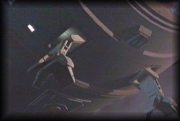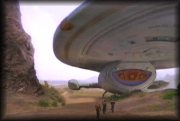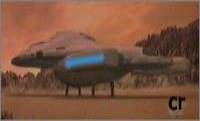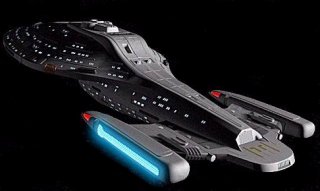


Statistics
Name: U.S.S. Eclipse
Class: Intrepid
Registry: Naval Construction Contract 75439 (NCC 75439)
Length: 1130 feet = 344.424 m
Width: 426.5 feet = 130 m
Height: 206.7 = 63 m
Weight: 1.5 million tons
Gross mass: 700,00 metric tons
Basic structure: extremely durable tritanium-duranium alloy
Maximum sustainable velocity: Warp 9.975
Decks: 15
Rooms: 257



Shuttle Bays: 1
(Deck 10)
Transporters: 2 personnel
(Deck 4) 4 cargo
Holodecks: 2 (Deck 6)
Brigs: 2
Turbo lifts: 1 system, 3 cars

Crew: 140 - 150
Life Support: 200 people maximum

Weapons:
11 phaser banks
4 torpedo launchers for the initially 38 photon torpedoes,
tri-cobalt bombs , tolmerite explosives



Landing capability:
Eclipse is able to land on a planet's surface. An antigravitational system
ensures that her weight doesn't cause any damage to the landing site.

Landing Eclipse can be broken down into a number of sequences:
(1) Warp core is taken offline.
(2) All plasma is vented from the nacelles.
(3) Atmospheric thrusters are engaged.
(4) Ship goes go to blue alert.
(5) Crew goes to code blue stations.
(6) Inertial dampeners increased to maximum.
(7) Landing struts are extended until they are locked.
(8) Inertial dampeners are released and adjusted to match the planet's gravity.
(9) The ship actually lands.
(10) Engines are disengaged.
(11) Thrusters exhaust is secured.






Deck-by-Deck Analysis:
Deck 1:
Bridge, Captain's Ready Room, and the Escape Pods.
Deck 2:
Mess Hall, Sensor Accessories, Senior Staff Quarters, Escape Pods, and
Storage.
Deck 3:
Senior Staff Quarters including the Captains, Photon Torpedo Trackers.
Deck 4:
Transporter Rooms 1 and 2, Photon Torpedo Launchers, Sensor Accessories, Escape
Pod Access.
Deck 5:
Sickbay(Doctor's Office), Sensor accessories, Escape Pods.
Deck 6:
Deflector, Computer Core, Holodecks, and Escape Pods.
Deck 7:
Mess Hall and Escape Pods.
Deck 8:
Docking Ports, Cargo Bays 1 and 2.
Deck 9:
Cargo Loading, Shuttle Dock, and Laboratories.
Deck 10:
Main Shuttle Bay, Primary Computer Core, Warp Core, Front Torpedo
Launchers, And Main Navigational Deflectors.
Deck 11:
Main Engineering, Main Computer and Deflector Control.
Deck 12:
Crew Quarters, Antimatter Tanks, and Escape Pods.
Deck 13:
Crew Quarters, Escape Pods.
Deck 14:
Ground Footpad System.
Deck 15:
Ground Footpad System, Antimatter Ports, and Tractor Beam.

Bio-neural circuitry:
Bio-neural circuits are an integral part of the Eclipse's computer core.
They consist of gel packs of bio neural cells that organize information
more efficiently and speed up response time. 48 replacement packs are
available.

Warp drive:
Ships of the INTREPID class have foldable nacelles that make warp propulsion
more efficient and secure than ever before. In 2370 it was learnt that
conventional warp drives pollute the space-time continuum. Movable
nacelles don't so that ships of that class may exceed the limit of Warp
5 then imposed by Starfleet Federation-wide. For a limited period of
time the Eclipse can sustain a maximum velocity of Warp 9.975.



Emergency medical holographic program:
The emergency medical holographic program is a holographic projection,
created and controlled by the computer. It can treat patients if the
actual doctor is not available.
Dr Lewis Zimmerman designed it with the assistance of Lt. Reginald
Barclay at the Jupiter Station Holoprogramming Center, where it was
activated on stardate 48308.2.

Photon torpedoes:
There are two aft photon torpedo launchers on Deck 4 and two forward photon
torpedo launchers on Deck 10.
Photon torpedoes are "smart" weapons and are capable of
tracking a moving target. Torpedoes are usually launched in clusters,
each independently targeted. The explosive power of a torpedo can be
varied by the amount of antimatter loaded into the magnetic bottle in
the casing.

Phasers:
Phasers, or Phased Energy Rectification, are the Eclipse's primary offensive
weapon. Phaser banks are located in the upper and lower phaser strips
and the two mid-hull phaser strips of the Primary Hull as well as a
ventral strip on the underside of the Engineering Hull.

Impulse Engines:
The impulse drive is powered by a series of fusion reactors located in both
aft wings on Deck 11. Another set of fusion reactors provides auxiliary
power to keep systems operational when both the warp drive and impulse
reactors are off-line. The impulse fusion reactors are fuelled by
deuterium.

Buzzard Collectors:
The front of the warp engine nacelles incorporates a set of powerful
electromagnetic coils called a Buzzard Collector. When the ship is traveling
at high speed, these coils generate an electromagnetic field
that collects stray atoms of interstellar hydrogen for use as fuel.

